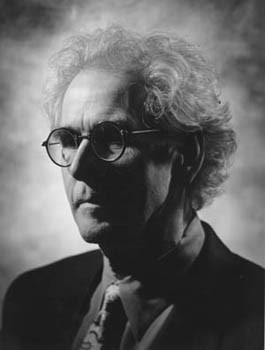Jerry N. Uelsmann
Photographer

1934 - 2022
Inducted in 1994
Biography
Jerry Uelsmann's photographs have been extensively exhibited and collected both nationally and internationally and his work has been exhibited in more than 100 solo shows worldwide. His highly recognized and acclaimed work broadened the parameters of photography as an aesthetic discipline.
Uelsmann has received a Guggenheim Fellowship and a National Endowment for the Arts Fellowship in Photography. He is a founding member of the American Society for Photographic Education and a Fellow of the Royal Photographic Society of Great Britain.
A Detroit native, Uelsmann took an interest in photography as a youth, eventually finding work as a wedding photographer. Encouraged by his father to pursue photography as a career, Uelsmann enrolled at Rochester Institute of Technology, training under noted fine art photographers Minor White and Ralph Hattersley. Uelsmann graduated in 1957, the same year that he saw his first photos appear in print, in an issue of Photography Annual magazine.
From Rochester, Uelsmann began graduate school at Indiana University, initially pursuing a degree in audio-visual communication. He soon realized that his interests lay elsewhere, so he transferred to the university's art department and earned a master's degree in 1958. At IU, he became heavily influenced by Henry Holmes Smith, already recognized as one of the most revered fine art photographers in the country. Uelsmann would later credit Smith with teaching him how a camera could be used as a serious creative medium rather than just a fancy tool for capturing images of the moment. In 1960, Uelsmann finished an MFA with Smith and soon landed his first job out of college as a photography instructor on the faculty of the University of Florida's Department of Art.
Uelsmann entered his teaching career just as photography began being accepted as an appropriate discipline in the art world, which traditionally had shunned it on largely aesthetic grounds. The traditional art world was facing transformation anyway, with the Pop art movement on the horizon. Uelsmann soon found himself at the vanguard of a movement to blend elements of Pop art with photography.
Inspired by such budding Pop art icons as Robert Rauschenberg and Joseph Cornell, Uelsmann began experimenting with a variety of darkroom techniques that gave vent to his creative urges. He developed techniques for combining multiple images into often stunning works of surrealist art. By 1965, Uelsmann had gained a reputation as the leading figure in the new field of Pop-art photography.
In 1967, Uelsmann's credentials as a serious photo-artist solidified when he was honored with a one-man exhibit at the Museum of Modern Art. That year he also won a Guggenheim Fellowship that recognized his multiple imaging techniques. His work soon got wide coverage in arts magazines both in the U.S. and in Europe, and his career blossomed.
Uelsmann's work has been exhibited in one-man and group shows in such venues as the George Eastman House, the National Museum of Modern Art in Kyoto, Japan and the National Gallery of Australia. Today, his work is represented in many private and public art collections, including the Museum of Modern Art, the Art Institute of Chicago and the Philadelphia Museum of Art.
Retired from his teaching career, Uelsmann still lived in Gainesville until his death on April 4, 2022, at the age 87. While the latter-day digital revolution in photography has essentially shut down darkrooms the world over–along with the manufacture of many types of film once considered the pillars of modern photography–Uelsmann remained true to his roots in film, declaring that his "creative process remains intrinsically linked to the alchemy of the darkroom."
Related Links
- Artist website - http://www.uelsmann.net/

